David Mailler says he’s happiest when he’s problem solving and, with more than 30 years’ farming experience as a livestock and grain grower, he’s become pretty good at it.
After a series of disheartening drought years between 2005 and 2007, and skyrocketing energy prices, David felt the growing need for a more cost-effective energy alternative that would lessen the burden of an “archaic centralised grid system” and help reduce power outages experienced by so many across regional Australia.
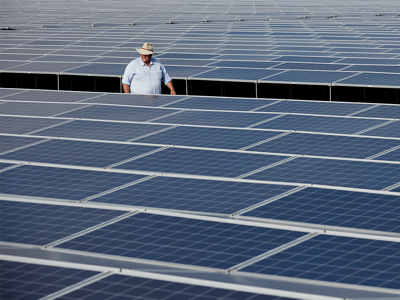 In 2012 the farmer, who is based in Uralla, New England, enrolled in a bachelor of sustainability degree at the University of New England and, after he graduated in 2017, Meralli Projects was born.
In 2012 the farmer, who is based in Uralla, New England, enrolled in a bachelor of sustainability degree at the University of New England and, after he graduated in 2017, Meralli Projects was born.
The family-run solar farm construction business built its first privately funded 4.77 megawatt (MW) solar farm, Chillamurra, on 120 hectares at Boggabilla in North West NSW in less than four months.
It was fully operational by June 2017. With a bit of practice up their sleeves, David’s father Michael and brothers Robert and Peter, set up a second, bigger 11.9MW solar farm, Dunblane, in Barcaldine, Queensland, in late 2017.
David says their solar farms have largely been built, funded and developed by regional investors
and farmers, and all are grid-connected projects that receive no government subsidies – an indication of the change in solar business models.
He says there are another four sites in the pipeline – one in Western Australia and three in NSW.
Government hurdles
According to David, government policy should be about promoting innovation for regional communities that empowers them to take control of their energy futures, rather than handicapping them with regulatory hurdles.
“It is a highly regulated industry and we’re running into problems now because we haven’t invested in the industry.
“The centralised grid idea is a legacy of the 1950s and 1960s, built to deal with last century’s electricity market.
A lot of power stations in NSW are coming to the end of their life – so we need to invest in an alternate system that decreases network pressure and overcapacity, making it economically viable for regional users.”
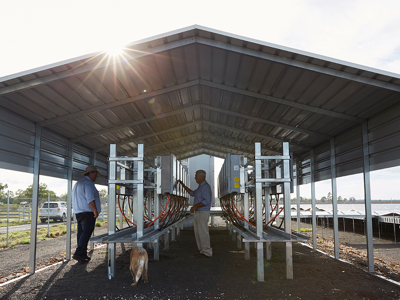 As a NSW Farmers executive councillor, he acknowledges a growth in agricultural users “coming up with their own solutions”, because they have been left with no other options.
As a NSW Farmers executive councillor, he acknowledges a growth in agricultural users “coming up with their own solutions”, because they have been left with no other options.
“The government is not interested in small-scale renewable projects anymore, all incentives find their way to large-scale projects.”
However, he says there is great potential to alleviate our energy requirements in remote areas by using micro-grids.
These are local energy grids that are capable of operating autonomously, and are powered, for example, by solar, hydro or wind. They can be highly effective if strategically installed in regional centres.
“Some 40% of people are using micro-grids in regional NSW, which in comparison is well above the state average (20-22%), so we’re actually well ahead of the curve in terms of renewables.”
He says micro-grids are particularly effective for individuals with high-intensity operations such as feedlots, because the investment needed to set them up can be justified.
“We’ve got unlimited options when it comes to energy production, energy storage and energy efficiencies. Yes, we have limitations with storage, but they’re solvable problems.”
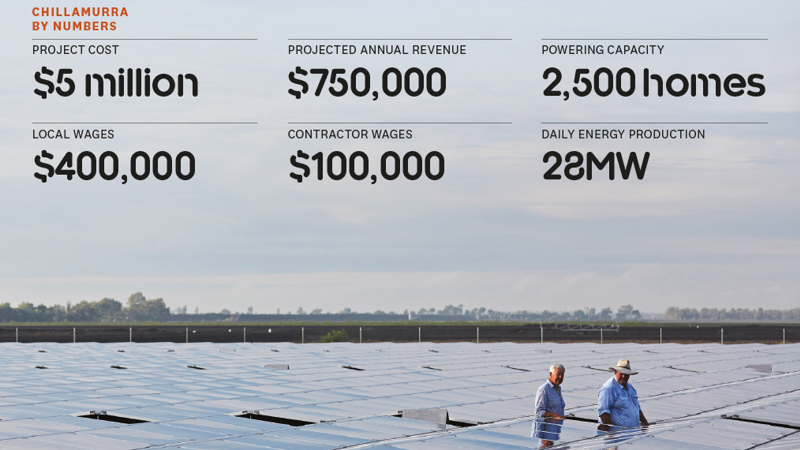
The high-tech breakthrough
The Chillamurra solar farm is the second largest of its kind in the world, with a fixed-tilt substructure located 80cm above ground that has reduced supply, transportation and installation costs by 40%.
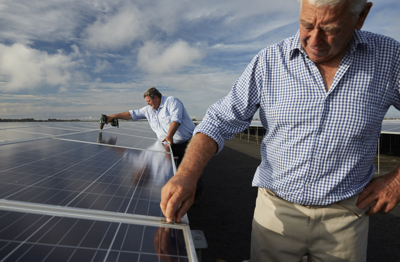
|
|
| A FAMILY CONCERN: Michael (foreground) and David manage day-to-day operations and maintenance of the solar farm, including performing regular checks of the solar panels. |
|
“The fixed-tilt design uses smaller panels with half facing west and half facing east, maximising the bell-curve capacity (peak sun exposure) as cost-efficiently as you can, using an efficient area consumption of 0.7ha per megawatt peak,” David says.
The installation is broken into three sub-arrays over 4ha, 25 panels long by 36 wide, using two transformers with a generational capacity of 3.6MW that produces 28MW hours per day, powering about 2,500 homes.
Chillamurra is making it easier for nearby towns to meet their energy needs, with the average household requirement in Boggabilla standing at 300 kilowatts (KW) per quarter, and the larger town of Goondiwindi needing 4.6MW to run all of its houses, David says.
This demonstrates the value of localised solar plants that provide regional users with affordable, reliable and accessible energy via sustainable means, offering economic security for the regional community, David says.
He acknowledges, however, that there’s no one-size-fits-all approach for regional NSW, be it micro-grids, embedded local networks, grid-connected renewable energy resources or off-grid projects.
But there is an opportunity to have a decentralised electricity system that generates and shares energy with the local regional community.
“We need to install a sense of generational equity into regional communities,” says David.
“Most communities have 20% youth unemployment, so it’s bringing focus to sustainability.
We’re going back to the time when the community is taking control of its own energy responsibilities. We have to be energy secure.”
The construction of the Chillamurra solar farm cost $5 million and it generates $750,000 annual income. This has helped boost the community’s economic growth, with $400,000 going to local wages and $100,000 to contractors during the construction.
It was built using largely unskilled labour, supported by specialists and a solid design.
David says his father and brothers’ farming background was integral to Chillamurra’s success, and he believes that simplified small-scale projects like this are ideal for reproduction on the land.
“As an installer, the skill sets that we require are all on tap with agriculture. You’ve got logistics, timelines... and problem-solving skills.”
David says the opportunities for solar energy are only restricted by people’s imagination, so why aren’t we taking advantage of them?
The next 30 years will be the greatest challenge, he says. “So how do we invest to ensure we get to the next generation of energy? There’s no good putting off the innovation of tomorrow.”
Harvesting for a sunny future
Since moving from the family farm, Toenda at Goondiwindi, in 2008, David has continued his farming ventures, running 60ha of grazing country with his wife Clare at Uralla, near Armidale in the Northern Tablelands.
With an undying passion for agriculture, he still manages to operate a farming and grain contracting business, despite clocking a lot of hours driving between Boggabilla and Uralla to manage the day-to-day operations of their solar farm.
|
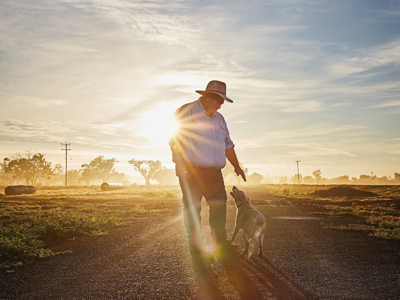
|
| |
LIGHTING THE WAY: David says harvesting sunshine to make electricity is not a big jump for farmers who have been using windmills to pump water for years. |
“We’re essentially doing the same as conventional agriculture, turning the abundant sunshine into a usable energy – food and fibre in traditional farming, and electricity in solar farming,” he says.
“It’s not a big step for us, though – we’ve been harvesting natural energy, using windmills to pump water for years.”
David says farmers have to adapt and grow and make the best of the situation – and there is no time to waste.
“In agriculture we want to see ourselves as good forbears, as thoughtful and generational mentors. There’s a perfect storm rising: with peak population, peak oil, water, soil and now the arrival and impact of climate change.
“If we don’t think about our children and their grandchildren, what are we doing this all for?”
Best bang for your buck
Understanding energy needs helps empower rural users
There’s a growing realisation, particularly in regional areas, that much of Australia’s future energy development will be localised or distributed – that is, generated and stored by a variety of small grid-connected devices.
“Retailers have gold-plated the price, they’ve got to get a return on the network, and policy dictates that they do that,” David says.
With rising electricity prices, David acknowledges the foresight of farmers – they’re always looking for the “biggest bang for their buck” and are continually adapting in the face of adversity to alleviate their economic pressures and, more recently, the impacts of climate change.
“Farmers understand how they use their power, they understand their energy needs. It’s pure economics,” he says.
Many regional and rural users have the generational capacity to replace their own energy requirements with on-farm solar installations (normally between 100KW and 300KW) or use ‘behind the meter’ options such as battery storage.
“But there’s a certain level of social responsibility with solar and it’s got an important place and demand in the grid,” David says. For now, that is, until enhanced network infrastructure is readily available.
“The real fears of managing people going off-grid is the social equity for people who can’t afford to go off-grid. It will become a poverty trap.
“If the masses disconnected from the centralised grid, the remaining user base who can’t afford solar infrastructure will be left to cop significant rises in network costs, resulting in a death spiral.
“We have to understand our needs and the needs of others on the network to ensure our social responsibility – there’s a community obligation [for now] to remain grid-connected in regional areas.”